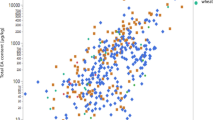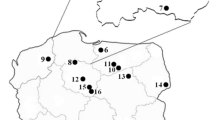Abstract
Because the occurrence of Claviceps in European pastures may have been overlooked to cause serious health problem for grazing animals, we documented the degree of Claviceps contamination in two horse pastures and estimated whether the horses could have ingested a critical quantity of alkaloids. We counted the Claviceps sclerotia and determined alkaloid levels using high performance liquid chromatography with fluorescence detection. Depending on the location, the number of sclerotia varied from 0.09 to 0.19 per square meter (central area) and from 0.23 to 55.8 per square meter (border strips). Alkaloid levels in individual sclerotia also varied in different genera of grasses, ranging from 0.98 ± 0.17 μg/kg in Agrostis sp. to 25.82 ± 9.73 μg/kg in Dactylis sp., equivalent to 0.98 μg/kg and 7.26 mg/kg. Sclerotia from Dactylis contained high levels of ergosine (0.209 % ± 0.100 %) and ergocristine (0.374 % ± 0.070 %). Depending on the localization in pastures, alkaloid levels in forage (dry matter, DM) ranged from 16.1 to 45.4 μg/kg in central areas and from 23.9 to 722 μg/kg in border strips. The amount of alkaloids that a horse could have ingested depended on its daily DM uptake, which was higher in the central areas (5.85 kg/day) than in the border strips (2.73 or 0.78 kg/day). In the central areas, this amount of alkaloids ranged from 94.2 to 265.9 μg/day; and in the border strips, from 65.3 (in 2.73 kg DM/day) to as much as 563.8 μg/day (in 0.78 kg DM/day). All these amounts are higher than the European averages for alkaloids ingested by horses via feedstuffs.

Similar content being viewed by others
References
Aboling S, Schultz G (1999) Randstreifen auf Mähweiden – Pflanzenbestand und Futterqualität aus der Sicht von Landwirtschaft und Naturschutz. Ber ü Landw 77:222–232 In German
Chernick W, Bobyock E, Bradford P (1989) 5-Hydroxytryptamine modulation of rat parotid salivary gland secretion. J Dent Res 68:59–63
Di Menna ME, Finch SC, Popay AJ, Smith BL (2012) Review of the Neotyphodium lolii/Lolium perenne symbiosis and its associated effects on animal and plant health, with particular emphasis on ryegrass staggers. New Zealand Vet J 60(6):315–328. doi:10.1080/00480169.2012.697429
EFSA, European Food Safety Authority (2005) Opinion on the scientific panel on contaminants in food chain on a request from the commission related to ergot as undesirable substance in animal food. EFSA J225:1–27
EFSA, European Food Safety Authority (2012) Scientific opinion on ergot alkaloids in food and feed. EFSA J 10(7):2798 1–158
EU (2002) European Union. Directive 2002/32/EC of the European Parliament and of the Council of 7 May 2002 on undesirable substances in animal feed. OJ L 140, 30.5.2002, p. 10–21
Boestfleisch C, Drotleff AM, Ternes W, Nehring S, Pazoutova S, Papenbrock J (2015) The invasive ergot Claviceps purpurea var. Spartinae recently established in the European wadden sea on common cord grass is genetically homogeneous and the sclerotia contain high amounts of ergot alkaloids European J of Plant Pathology 141:445–461
Cawdell-Smith AJ, Scrivener CJ, Bryden WL (2010) Staggers in horses grazing paspalum infected with Claviceps paspali. Austr Vet J 88:393–395
Clay K (1988) Clavicipitaceous fungal endophytes of grasses: coevolution and the change from parasitism to mutualism. Academic, London
Flachowsky G, Kamphues J, Rodehutscord M, Schenkel H, Staudacher W, Südekum KH, Susenbeth, Windisch W (2014) Empfehlungen zur Energie- und Nährstoffversorgung von Pferden. Frankfurt/M. In German
Guitart R, Croubels S, Caloni F, Sachana M, Davanzo F, Vandenbroucke V, Berny P (2010) Animal poisoning in Europe. Part 1: farm livestock and poultry. Vet J 183:249–254
Handeland K, Vikoren T (2005) Presumptive gangrenous ergotism in free-living moose and a roe deer. J of Wildlife Diseases 41:636–642
Hofmann RR (2007) Wildtiere in Bildern zur vergleichenden Anatomie. Schaper, Hannover In German
ICH (1996) International Conference on Harmonization (ICH) of Technical Requirements for the Registration of Pharmaceuticals for Human Use, Validation of analytical procedures: Text and Methodology. ICH-Q2B, Geneva
Kamphues J, Coenen M, Kienzle E, Pallauf J, Simon O, Zentek J (2014) Supplemente zu Vorlesungen und Übungen in der Tierernährung. Hannover. In German
Kamphues J, Drochner W (1991) Mutterkorn in Futtermitteln – ein Beitrag zur Klärung möglicher mutterkornbedingter Schadensfälle. Tierärztl Praxis 19:1–7 In German
Katzung BG (1997) Farmacologia generale e clinica. Piccin Nuova Libraria, Padova Italia, pp. 288–293 In Italian
Krska R, Stubbings G, Macarthur R, Crews C (2008) Simultaneous determination of six major ergot alkaloids and their epimers in cereals and foodstuffs by LC-MS-MS. Anal Bioanal Chem 391(2):563–576
Lorinser CJ (1824) Versuche und Beobachtungen über die Wirkung des Mutterkorns auf den menschlichen und thierischen Körper, großentheils aus actenmäßigen Quellen und mit besonderer Rücksicht auf die medicinische Polizey. In: Hufeland CW, Osann E (eds) Volume 52. Berlin. In German
Lev-Yadun S, Halpern M (2007) Ergot (Claviceps purpurea)—an aposematic fungus. Symbiosis 43:105–108
Loken T, Ulvund MJ, Vag T (1979) Case of gangrenous ergotism in grazing sheep. Acta Vet Scand 20:601–603
Merkel S, Dib B, Maul R, Koeppen R, Koch M, Nehls I (2012) Degradation and epimerization of ergot alkaloids after baking and in vitro digestion. Anal Bioanal Chem 404:2489–2497
Meyer H, Coenen M (2002) Pferdefütterung. Enke, Hannover In German
Millar M, Smith R, May P (2010) Ergot poisoning of water buffaloes in the UK. Vet Rec 166:28–29
Müller C, Klaffke HS, Krauthause W, Wittkowski R (2006) Determination of ergot alkaloids in rye and rye flour. Mycotoxin Res 22:197–200
Müller C, Kemmlein S, Klaffke H, Krauthause W, Preiss-Weigert A, Wittkowski R (2009) A basic tool for risk assessment: a new method for the analysis of ergot alkaloids in rye and selected rye products. Mol Nutr Food Res 53(4):500–507
Noble JW (1985) Suspected poisoning of cattle by Claviceps ssp. On water couch. Austr Vet J 62:432–433
Oldenburg E (1997) Endophytic fungi and alkaloid production in perennial ryegrass in Germany. Grass Forage Sci 52:425–431
Omacini M, Chaneton EJ, Ghersa CM (2005) Neotyphodium in cool-season grasses. In: Roberts C, West C, D. S (eds) A hierarchical framework for understanding the ecosystem consequences of endophyte–grass symbiosis. Blackwell Publishing, UK, pp. 141–161
Paterson RRM, Lima N (2011) Further mycotoxin effects from climate change. Food Res Intern 44:2555–2566
Pazoutova S, Olsovska J, Linka M, Kolinska R, Flieger M (2000) Chemoraces and habitat specialization of Claviceps purpurea populations. Appl and Environmental Microbiology 66:5419–5425
Perez LI, Gundel PE, Ghersa CM, Omacini M (2013) Family issues: fungal endophyte protects host grass from the closely related pathogen Claviceps purpurea. Fungal Ecol 6:379–386
Provenza FD, Villaba JJ, Bryant JP (2003) Foraging by herbivores. Linking the biochemical diversity of plants to herbivore culture and landscape diversity. Island Press, Washington
Reed KFM, Walsh JR, Cross PA, Mc Farlane NM, Sprague MA (2004) Ryegrass endophyte (Neotyphodium lolii) alkaloids and mineral concentrations in perennial ryegrass (Lolium perenne) from southwest victorian pasture. Austr J of Exp Agriculture 44:1185–1194
Riet-Correa F, Rivero R, Odriozola E, de Adrien ML, Medeiros RMT, Schild AL (2013) Mycotoxicoses of ruminants and horses. J of Vet Diagnostic Investigation 25(6):692–708
Smith DJ, Shappell NW (2002) Technical note: epimerization of ergopeptine alkaloids in organic and aqueous solvents. J of Animal Sc 80:1616–1622
Uhlig S, Vikoren T, Ivanova L, Handeland K (2007) Ergot alkaloids in norwegian wild grasses: a mass spectrometric approach. Rapid Commun Mass Spectrom 21:1651–1660
Wali PP, Wali PR, Saikkonen K, Tuomi J (2013) Is the pathogenic ergot fungus a conditional defensive mutualist for its host grass? PLoS One 8:1–8
Wright B, Kenney D (2001) Ergot alkaloid (ergopeptine) toxicity in horse hay and pasture http://www.omafra.gov.on.ca/english/livestock/horses/facts/info_ergot_alkaloid.htm: Ministry of Agriculture, Food, and Rural Affairs. Access date: 1 March 2016
Zbib N, Repussard C, Tardieu D, Guerre P (2014) Toxicity of mycotoxins produced by endophytic fungi of the genus Neotyphodium. Rev Med Vet 165(3/4):116–135
Acknowledgments
The authors would like to thank the pasture owners who allowed us to work on their property; Kirsten Moritz and Susanne Ohlsen, who discovered the sclerotia in pastures, assisted in the field work, and provided data for the case reports; and Dr. Martina Buchholz and Jutta Barras-Akhnoukh for kindly helping with the analytical work.
Author information
Authors and Affiliations
Corresponding author
Ethics declarations
Conflict of interest
The authors declare no conflict of interest.
Electronic supplementary material
ESM 1
(DOCX 697 kb)
Rights and permissions
About this article
Cite this article
Aboling, S., Drotleff, A.M., Cappai, M.G. et al. Contamination with ergot bodies (Claviceps purpurea sensu lato) of two horse pastures in Northern Germany. Mycotoxin Res 32, 207–219 (2016). https://doi.org/10.1007/s12550-016-0253-y
Received:
Revised:
Accepted:
Published:
Issue Date:
DOI: https://doi.org/10.1007/s12550-016-0253-y




